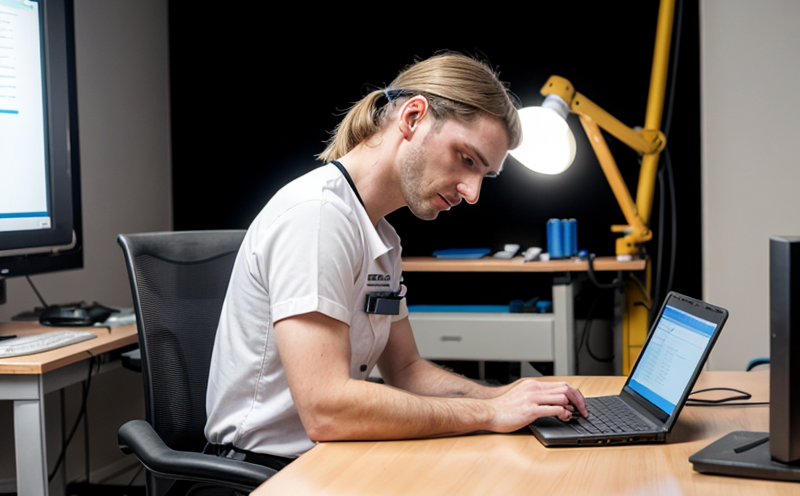RTCA DO-371 Flight Deck Display Readability Testing
The RTCA DO-371 standard sets forth rigorous requirements to ensure the readability of flight deck displays, which is critical in aviation safety. This testing is essential because poor display readability can lead to errors and delays that may compromise a pilot's situational awareness and decision-making capabilities during critical phases of flight.
The objective of RTCA DO-371 testing is to evaluate how well pilots can read information from the cockpit displays under various lighting conditions, including direct sunlight. This includes verifying that the text on these displays remains legible despite glare and reflections. The standard also addresses the contrast between characters and background as it affects readability.
The process involves simulating real-world flight conditions to ensure that all components of a display system are functioning correctly. This includes testing under different ambient light levels, measuring how well pilots can distinguish text from the background, and assessing the overall visibility of symbols and numbers.
Test specimens used in this procedure typically include prototype cockpit displays or actual flight deck sections that have been modified to include the elements being tested. The testing apparatus comprises a controlled environment chamber capable of simulating various lighting conditions found at different altitudes and times of day.
The acceptance criteria for RTCA DO-371 are stringent, focusing on ensuring that all information displayed is easily readable by pilots under standard operating conditions. Compliance with this standard helps manufacturers meet regulatory requirements set forth by organizations like the FAA and other aviation authorities globally.
The real-world application of RTCA DO-371 testing is significant, especially in light of recent incidents where poor display readability has been identified as a contributing factor. By adhering to these standards, manufacturers can enhance safety and reduce the risk of human error due to misinterpretation or misunderstanding of critical flight information.
The implications for quality management teams are clear: ensuring compliance with RTCA DO-371 not only meets regulatory requirements but also contributes to improving overall aviation safety. This is particularly important given the increasing complexity of modern cockpit systems and the demand for more intuitive user interfaces.
Applied Standards
The primary standard applied in this testing process is DO-371, which specifies the requirements for flight deck display readability. This document ensures that all text and symbols are readable under a range of lighting conditions, including direct sunlight.
- Lighting Conditions: The standard covers various ambient light levels commonly encountered in different parts of the world at varying altitudes.
- Text Contrast: It specifies minimum contrast ratios between characters and their backgrounds to ensure readability.
Compliance with RTCA DO-371 is mandatory for manufacturers aiming to meet regulatory requirements set forth by aviation authorities. Adherence to these standards helps prevent potential safety hazards associated with unreadable flight deck displays, thereby enhancing overall aviation safety.
Scope and Methodology
The scope of RTCA DO-371 testing encompasses the evaluation of the readability of all text, symbols, and other graphical elements displayed on flight deck instruments. This includes checking for adequate contrast between characters and their backgrounds under various lighting conditions.
The methodology involves simulating real-world flight environments to ensure that all components of a display system function correctly. This includes testing in controlled laboratory settings designed to mimic the conditions pilots would encounter during actual flights.
- Controlled Environment Chamber: The test specimens are placed inside a chamber that can adjust its lighting conditions to simulate different altitudes and times of day.
- Lighting Simulation: Various ambient light levels are used to replicate the conditions found in various parts of the world. This includes direct sunlight, which is particularly challenging for display readability due to glare.
- Readability Assessment: Pilots or trained personnel assess how well they can read all information displayed under each set of lighting conditions.
The acceptance criteria for RTCA DO-371 are based on ensuring that all text and symbols remain legible and easily interpretable by pilots. Compliance with these standards is crucial for manufacturers to ensure their products meet regulatory requirements and contribute to enhanced aviation safety.
Quality and Reliability Assurance
- Data Consistency: Regular audits of testing data are conducted to ensure consistency across multiple test runs. This helps in maintaining the accuracy and reliability of results.
- Environmental Control: The laboratory conditions used for testing are closely monitored to maintain stability, ensuring that variations due to environmental factors do not affect the outcomes.
The quality assurance process also includes periodic calibration of all test equipment to ensure accurate measurements. This is crucial in maintaining high standards and preventing any discrepancies from influencing the final results. Additionally, detailed documentation of each testing session is kept for future reference and verification purposes.
Reliability assurance focuses on ensuring that the testing methods and procedures are robust enough to consistently produce reliable outcomes. This involves regular reviews of test protocols and methodologies to identify areas for improvement or enhancement. Continuous training and certification of personnel involved in the testing process further contribute to maintaining high standards of reliability.





